This technological competition concerning the future of humanity has now entered the "sprint" phase.

Image source: Generated by Wujie AI
As 2025 has just begun, China has sparked an unprecedented wave in the AI field.
DeepSeek has emerged as a dark horse, sweeping the global market with its advantages of "low cost + open source," achieving top rankings in both the iOS and Google app stores. According to data from Sensor Tower, as of January 31, DeepSeek's daily active users have reached 40% of ChatGPT's, and it continues to expand at a rate of nearly 5 million new downloads per day, being referred to in the industry as a "mysterious force from the East."
In the face of the "formidable" DeepSeek, Silicon Valley has yet to reach a consensus.
Palantir CEO Alex Karp stated in an interview that the rise of competitors like DeepSeek indicates that the U.S. needs to accelerate the development of advanced artificial intelligence. Sam Altman mentioned in an interview with Radio Times that while DeepSeek has performed well in terms of product and pricing, its emergence is not surprising. Elon Musk has repeatedly stated that there are no revolutionary breakthroughs, and soon teams will release models with better performance.
On February 9, a series of live broadcasts titled "Revisiting DeepSeek's Achievements and the Future of AGI," initiated by Weicai Zhiku, the 50 People Forum on Information Society, and Tencent Technology, invited three guests: economist Zhu Jiaming, Chairman of the Academic Committee of the Hengqin Digital Finance Research Institute, Wang Feiyue, Supervisor of the Chinese Automation Society and researcher at the Institute of Automation, Chinese Academy of Sciences, and He Baohui, founder of EmojiDAO, to share insights on topics such as "AGI Development Path," "How to 'Replicate' the Next DeepSeek," and "Decentralization of Large Models."
Professor Zhu Jiaming is extremely optimistic about the speed of AI development. He stated that the technological progress cycle in primitive society was measured in hundreds of thousands of years, in agricultural society in thousands of years, in industrial society in hundreds of years, and in the internet era in about ten years. Now entering the era of artificial intelligence, the speed has accelerated unimaginably. "From now on, artificial intelligence will move towards AGI or ASI; conservatively speaking, it will take 2-3 years, and more conservatively, 5-6 years."
In Professor Zhu Jiaming's view, the future development of artificial intelligence will diverge into two paths: one is a more cutting-edge, high-cost route aimed at exploring unknown areas of humanity; the other is a low-cost, large-scale popularization route. "There will always be two paths in the development of artificial intelligence towards a new stage: one is from '0 to 1' and the other is from '1 to 10.'"
Professor Wang Feiyue emphasized that the achievements of DeepSeek today have reshaped confidence in China's investment and leadership in AI technology and industry, based on the development of AI technology both domestically and internationally. He believes that OpenAI will not share superintelligence but will only corner other companies.
Regarding how to incubate more teams like DeepSeek, Wang Feiyue cited the cases of AlphaGo and ChatGPT to emphasize the value of the DeSci decentralized research model, stating, "We cannot rely solely on planning and a national system to develop AI technology."
As for the widespread use of data distillation technology by DeepSeek, there have been many critical voices in the industry, even comparing distillation to theft. Wang Feiyue expressed his desire to "vindicate" knowledge distillation, saying, "Knowledge distillation is essentially a transformation of an educational form; just because a person's knowledge comes from a teacher does not mean they cannot surpass the teacher."
He Baohui, like Wang Feiyue, values decentralization. He believes that decentralization is the path to reducing costs for deep learning models and is also key to computing networks and data security.
"The decentralized computing network and data storage, such as Filecoin, have storage costs far lower than traditional cloud services (like AWS), significantly reducing costs," He Baohui said. "A decentralized management mechanism ensures that no one can unilaterally change these networks and data."
Regarding agents after large models, He Baohui views them as a form of life, stating, "I believe it is not just a tool but a form of life. Creating AI does not mean completely dominating it." He added, "I am very concerned about how to enable agents to achieve 'immortality' and exist independently in a decentralized network, becoming a brand new 'species.'"
Below are the highlights from the live broadcast sharing (with some edits and adjustments without changing the original meaning):
Zhu Jiaming
The Development of Artificial Intelligence
Only Two Paths: "0 to 1" and "1 to 10"
Today, I want to discuss the topic of the evolutionary scale of artificial intelligence and large models, with the subtitle being an analysis of the DeepSeek V3 and R1 series phenomena.
I will mainly address five questions: the time scale of AI evolution, the AI ecosystem, how to comprehensively and objectively evaluate DeepSeek, the global response triggered by DeepSeek, and the outlook for AI trends in 2025.
First, the actual time scale of AI evolution is much faster than expected by experts, including scientists in the AI field.
Throughout human history, we have experienced agricultural society, industrial society, and information society, and now we are entering the era of artificial intelligence. In this historical process, the time cycle of technological evolution has been continuously shortened.
In primitive society, the cycle of technological progress was measured in hundreds of thousands of years; in agricultural society, it was in thousands of years; in industrial society, the cycle of technological progress ranged from 10 to 100 years; in the internet era, it was measured in 10 to 30 years; and now, entering the era of artificial intelligence, the speed has accelerated beyond imagination.
Before the emergence of GPT-3, people estimated that it would take about 80 years for artificial intelligence to reach the AGI era; after GPT-3 appeared, this expectation was shortened to 50 years; and by the time LLaMda2 was released, the expectation had changed to 18 years.
By 2025, the expectation for achieving AGI may be even shorter, conservatively speaking, 5-6 years, and optimistically, also 5-6 years.
In the comparison shown in the following image, we can clearly see that artificial intelligence exhibits obvious acceleration characteristics compared to any technological revolution or innovation in human history.
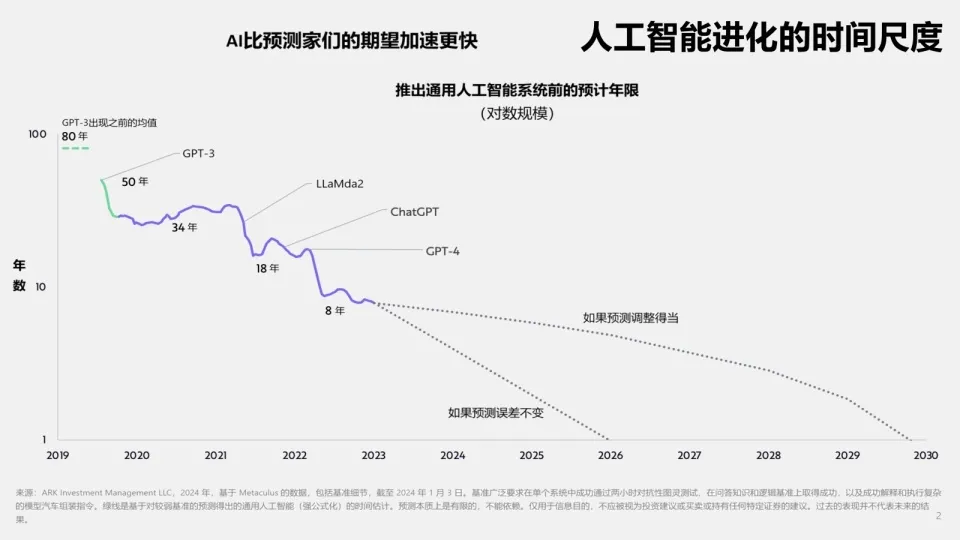
If we use the first, second, and third cosmic speeds to describe the current rapid development of artificial intelligence, we can say that artificial intelligence has completed the transition from the first cosmic speed to the second cosmic speed—AI is beginning to enter a state of high autonomy, breaking free from human constraints.
As for the conditions under which it breaks free from the sun's gravitational pull to enter the third cosmic speed, we do not know. But it is certain that artificial intelligence has completed the leap from general artificial intelligence to superintelligence. Since 2017, artificial intelligence has been undergoing drastic changes and upgrades at a frequency of years, months, and weeks.
Why does artificial intelligence exhibit exponential acceleration and enter the "second cosmic speed" phase? I believe there are three very important reasons.
● First, as Musk mentioned, by the end of 2024, the data used for training models will be exhausted, and large models will have basically consumed all of humanity's existing knowledge. Starting in 2025, the larger goal of large models will be to seek incremental data, marking a historic turning point—artificial intelligence large models have completed the transformation from extensive to intensive;
● Second, the hardware for artificial intelligence continues to evolve;
● Third, artificial intelligence has entered a development stage that "depends on artificial intelligence itself"—it can develop autonomously.
Currently, the large model matrices of companies like OpenAI, DeepMind, and Meta form a mechanism of interdependence and mutual promotion. The construction of the AI ecosystem follows the law of vertical speed breakthroughs driving horizontal ecological fission. At the horizontal ecological level, three paradigms—the multimodal fusion revolution, vertical domain penetration acceleration, and distributed cognitive networks—are reconstructing the technological landscape.
In a continuously maturing AI ecosystem, spillover effects (generalization effects) naturally arise and essentially permeate the realms of science, economy, society, and human cognition.
Regarding the phenomenon of the sensational product DeepSeek that exploded in popularity during the Spring Festival, how can we comprehensively and objectively evaluate DeepSeek?
First, DeepSeek has garnered continuous attention from domestic and international media and has led to widespread experiential use around the world, creating a massive shockwave. Public opinion has historically played a very important role. Some events are amplified by public opinion, while others are underestimated, and after a period, they will ultimately return to their original state in history.
DeepSeek V3 primarily possesses four significant advantages: high performance, efficient training, rapid response, and particularly suitability for the Chinese environment. DeepSeek-R1 mainly includes strong computing performance, excellent reasoning ability, good functional characteristics, and strong scene applicability.
Of course, DeepSeek also faces some challenges or issues that need improvement—how to improve accuracy? How to solve the multimodal output and input issues? The stability of servers in terms of hardware, and how to handle the increasingly numerous sensitive topics that cannot be avoided.
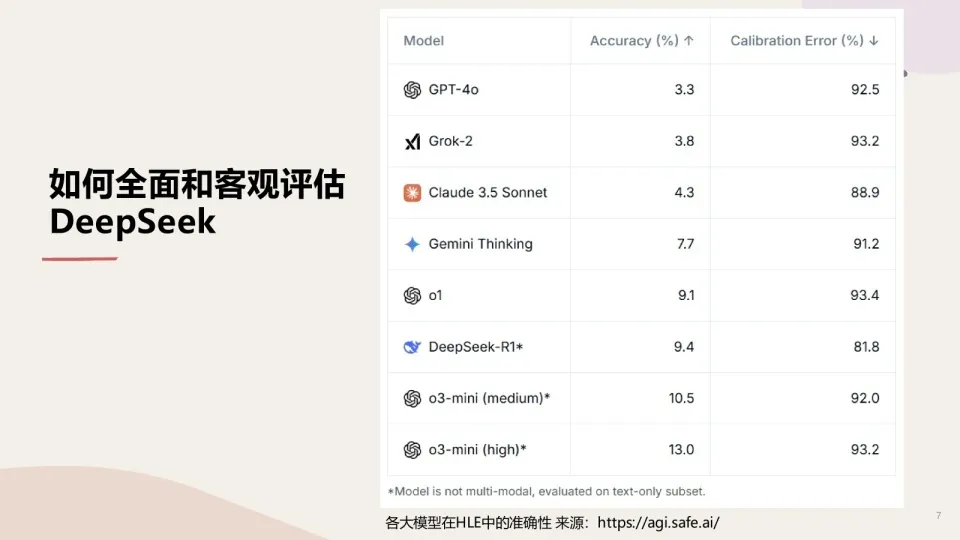
Among these issues, the most worth discussing and the most concerning to everyone is the cost of large AI models, which has a series of fundamental differences in concept and structure compared to the cost of industrial products.
The cost of large AI models primarily lies in infrastructure. The reason DeepSeek shows its superiority in infrastructure costs is due to the extensive use of relatively low-priced A100 chips; secondly, there are R&D costs, which involve the cost of algorithm reuse, where DeepSeek has certain advantages; furthermore, attention needs to be paid to data costs, the cost of introducing emerging technologies, and the cost structure in comprehensive computing.
Discussions about costs will also involve issues of technological routes—there will always be two paths in the development of artificial intelligence towards a new stage: one is from "0 to 1" and the other is from "1 to 10." In any future development stage, if the "0 to 1" route is chosen, costs will inevitably rise; whereas choosing the "1 to 10" route may allow for cost reduction through increased efficiency.
Under the "0 to 1" route, DeepSeek has performed commendably in benchmark tests, especially in the HLE (Humanity’s Last Exam) standard set—which compiled 3,000 questions designed by over 500 institutions from 50 countries and regions, covering core capability assessments such as knowledge reserve, logical reasoning, and cross-domain transfer.
In the HLE benchmark test, DeepSeek achieved an accuracy score of 9.4, with OpenAI o3 being stronger; of course, it far surpassed GPT-4o and Grok-2 in this field, which is quite an impressive achievement.
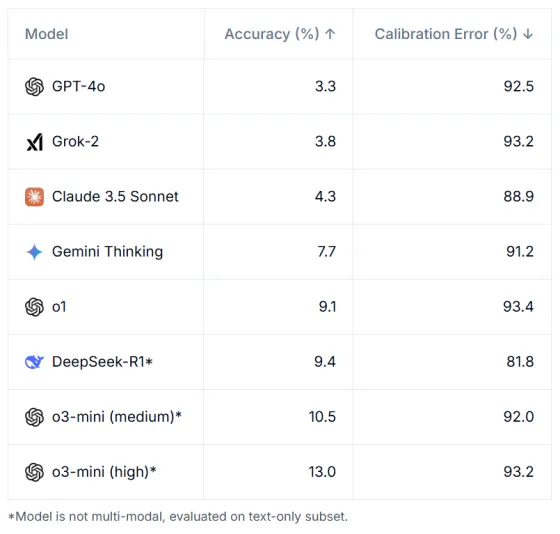
We all know that after the launch of DeepSeek, global AI companies, including Microsoft, Google, and NVIDIA, have reacted to varying degrees. This indicates that the balance point in the evolution of artificial intelligence is constantly being disrupted—when a brand new breakthrough in AI occurs, it creates pressure that stimulates the entire system to respond; this response then gives rise to new breakthroughs, generating new pressure and forming a new balance point.
Currently, the cycle of influence and response is continuously shrinking. We find that the competition in artificial intelligence is a rather divergent model, providing significant development space for innovation and breakthroughs.
In the outlook for the evolutionary scale of artificial intelligence and the ecosystem of large models, technological development presents a dynamic cycle model of "leading—challenging—breaking through—leading again." This process is not a zero-sum game but rather a spiral ascent of the overall ecosystem driven by continuous iteration.
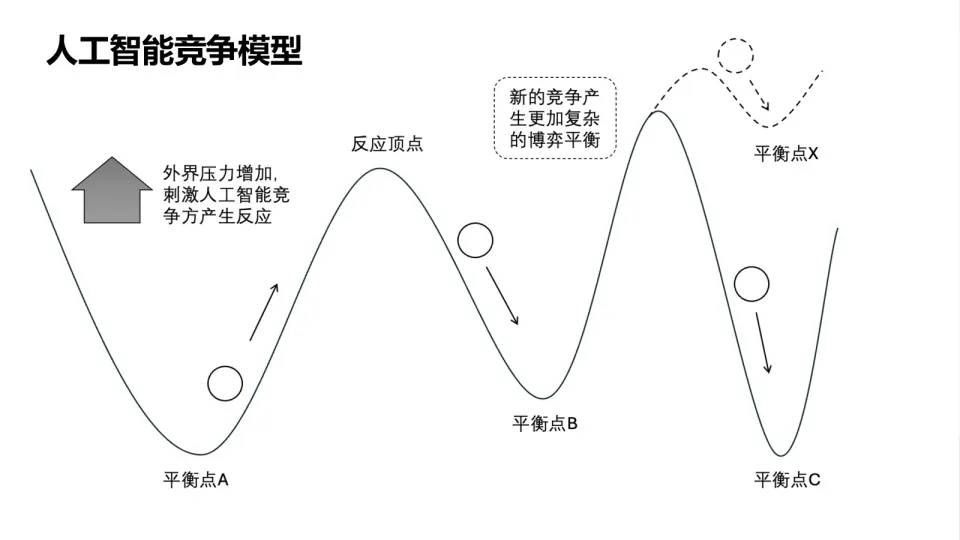
Finally, I would like to discuss the outlook for the development trends of artificial intelligence in 2025.
Artificial intelligence has reached a point where there are two directions: one is a specialized high-end route, expanding the frontier and exploring unknown areas. The other path is the popularization route, where large models aim to lower the barriers to use and meet the needs of a broad user base.
Now, humanity has entered a brand new era where artificial intelligence serves as both a microscope and a telescope, helping us understand aspects of the physical world that are currently beyond the reach of both.
In the future, artificial intelligence will inevitably present a diverse and multidimensional pattern. Like LEGO blocks or even similar to a Rubik's Cube, they will continuously combine and reconstruct, creating a new world that exceeds our own knowledge and experience limitations.
Further breakthroughs in artificial intelligence require increasing capital investment. The demand for AI is rapidly consuming existing data center capacities, prompting companies to build new facilities.
In summary, artificial intelligence is moving towards "reaching for the sky and standing on the ground": "reaching for the sky" means improving the quality of simulating the physical world while continuously exploring unknown areas; "standing on the ground" means being grounded, promoting AI to lower costs, and achieving comprehensive implementation that benefits the public. In this context, we can more objectively and comprehensively see the advantages, limitations, and future potential of DeepSeek.
Wang Feiyue
OpenAI Will Corner Other Companies
"Replicating" DeepSeek Relies on Decentralized Research
In a sense, DeepSeek is a great social achievement today, and its influence is unparalleled by past technological breakthroughs—its technological value and commercial value are lower than the economic value it may bring in the future, and even lower than its potential impact on society, particularly on the current international competitive landscape and international politics. After OpenAI became ClosedAI, DeepSeek has restored confidence and hope in open-source initiatives internationally, which is very valuable.
I do not intend to discuss the specific details of this technology, as it has already been talked about extensively; I just want to express my feelings.
I am very pleased that China has finally achieved a "zero" breakthrough in this field, breaking the myth and near-monopoly of OpenAI, forcing it to change its behavior. Especially since OpenAI is no longer open and will not share its "super" intelligence with society, particularly the international community, its success will only corner other companies, including American ones. I still hope that countries and individuals can maintain normal technological competition rather than technological warfare.
This is a very significant event; DeepSeek has instilled greater confidence in everyone regarding China's technological progress, especially in the development of artificial intelligence.
I believe that the essence of emerging commodities in the era of intelligence is trust and attention, and DeepSeek has provided us with both, reflecting its important value. What the entire society needs to do next is to transform trust and attention into "new quality commodities" that can be produced and circulated on a large scale, making the intelligent society a reality and bridging the gap between agricultural and industrial societies.
Next, I want to vindicate knowledge distillation.
There are some sarcastic remarks about knowledge distillation on social networks, such as "begging for food from others" and "fishing in someone else's basket," which are actually deliberate misinterpretations of knowledge distillation. Knowledge distillation is essentially a transformation of an educational form; just because a person's knowledge comes from a teacher does not mean they cannot surpass the teacher. Of course, large models, from ChatGPT to DeepSeek, must generate or enhance their reasoning abilities, avoiding "playing tricks," and aim for AI for AI, vindicating knowledge distillation for themselves.
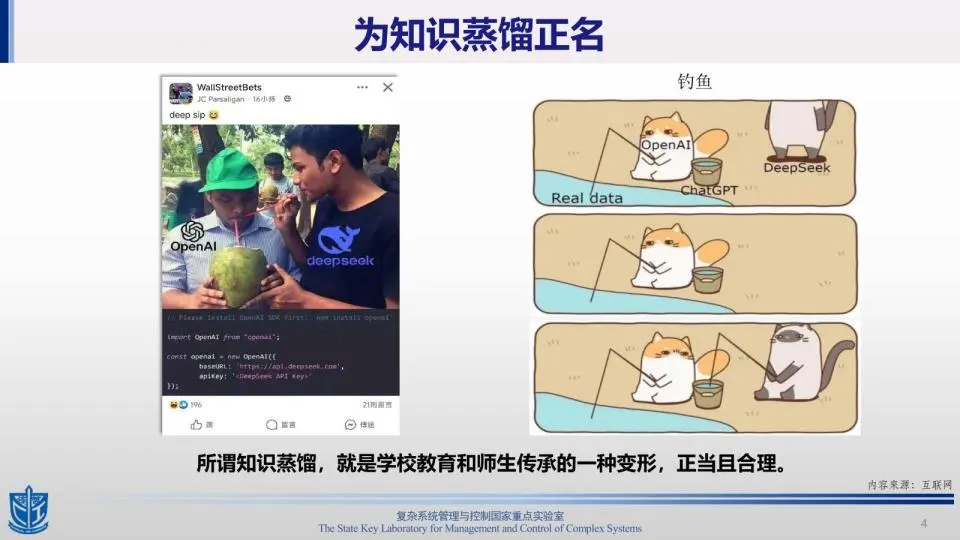
Regarding the question of "what to do after DeepSeek," we must first discuss the two technological development models: decentralized research (DeSci) and centralized research (CeSci). AlphaGo, ChatGPT, and DeepSeek are all products of the DeSci model, which involves distributed and decentralized autonomous scientific research; in contrast, CeSci is research organized and planned by the state.
I believe we must recognize the role of DeSci and cannot rely solely on planning or a national system to promote the development of AI technology.
Because the foundation of AI technology is diversity, as one of the main initiators of AI, Marvin Minsky, said: "What is the incredible trick that makes us intelligent? The trick is that there is no trick. The power of intelligence comes from our own immense diversity, not from any single, perfect principle."
Therefore, excessive strategic planning may actually limit the natural development of diversity. Before effective models or technologies "emerge," DeSci should take precedence. After a certain level of genuine innovation has emerged, we can then guide the technology to accelerate towards established goals through the state-led CeSci model. We must avoid "ivory tower" behavior, especially during this significant transformation period in intelligence.
For those of us who have been working in the AI field for a long time, the current AI and past AI are two different worlds.
In the past, AI referred to artificial intelligence; now it has gradually transformed into agentic intelligence. In the future, the term may further evolve into autonomous intelligence, becoming a new AI, particularly self-organizing autonomous intelligence, which is AI for AI or AI for Autonomous Systems (AS), marking a new stage in the development of AI driving AI. This aligns with what John McCarthy, one of the founders of artificial intelligence, said: the ultimate goal of AI is the automation of intelligence, which is essentially the automation of knowledge.
Whether now or in the future, the three types of "AI"—old, outdated, and new—will coexist, and I will collectively refer to them as "parallel intelligence."
I have also publicly stated my position: although I have pursued explainable AI for over 40 years, I believe that intelligence is essentially unexplainable. I have adapted Pascal's wager—AI is unexplainable, but it can and must be governed. Simply put: no need to explain, governance is essential.
Everyone talks about "AI for Good," but if you remove one "o," it becomes "AI for God," which could turn AI into a monopolistic tool. Therefore, it is essential to have both "o's" to ensure diversity and prioritize safety, strengthening governance to prevent phenomena like the mutation of OpenAI, ensuring the correct direction of technological development.
I am very pleased to see the progress of DeepSeek, but some discussions are still premature; there is no need to scare everyone with "general artificial intelligence." There is no need for excessive worry; in fact, worrying is futile; development is inevitable.
Researchers need to have a broader perspective and avoid internal competition; we must transform SCI into "SCE++"—Slow, taking time to calm down and conduct research; Casual, engaging in research without a profit-driven focus; and finally, Easy, pursuing simplicity and elegance, with a focus on quality and enjoyment in scientific work. This is what artificial intelligence should bring to our lives.
He Baohui
Large Models Should Also Be "Decentralized"
I Want to See Agents Achieve Immortality
I am not a professional in the AI field and have only recently begun to delve into the history of AI. I would like to share my current work and my views on the potential changes brought about by DeepSeek, based on my experience in the Web3 industry since 2017.
First, I want to emphasize a fundamental issue: there are significant differences between the underlying models of DeepSeek and OpenAI, and it is this difference that has truly shocked the Western world.
If DeepSeek were merely replicating Western technology, they would not feel such a shock, nor would it provoke such widespread discussion, forcing all major companies to take it seriously. What truly astonished them is that DeepSeek has successfully navigated a distinctly different path.
OpenAI adopts the SFT (Supervised Fine-Tuning) route, relying on manually labeled large datasets to generate content through probabilistic models. Its innovation lies in accumulating these results through extensive manual labor and high costs.
A few years ago, AI technology was considered nearly impossible to achieve, but the emergence of OpenAI overturned this view and pushed the industry towards the SFT technology route.
DeepSeek has utilized almost no SFT technology; instead, it has adopted a cold-start approach through reinforcement learning, exploring unknown paths.
This method is not new; the first version of Google DeepMind's AlphaGo relied on extensive data learning, while the second version, AlphaGo Zero, relied entirely on rules and achieved better results through self-play and exploring 10,000 games.
Using reinforcement learning for cold starts is quite challenging, and training can be unstable, which is why it is rarely adopted. However, I personally believe this may be the true path to AGI, rather than simply relying on data tuning.
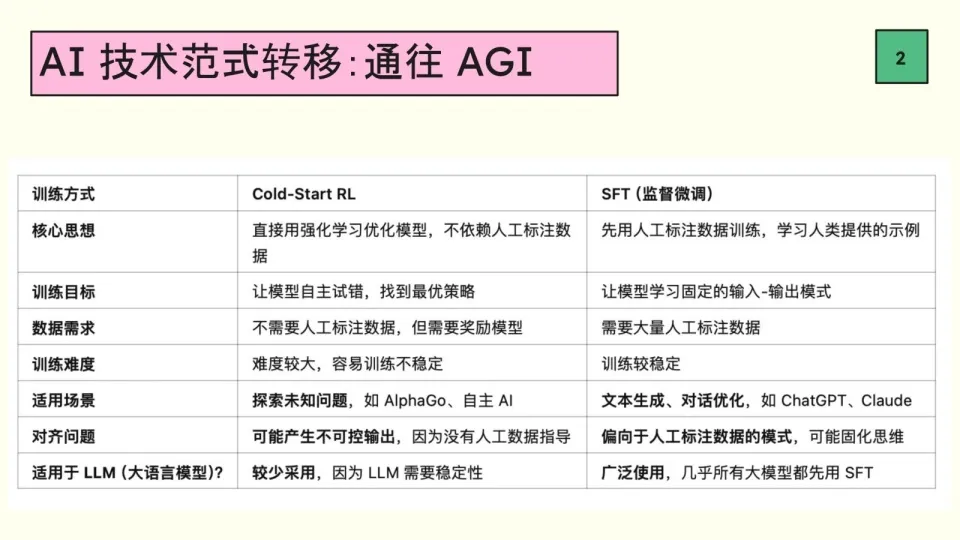
In the past, data adjustment methods resembled big data integration, while DeepSeek genuinely seeks conclusions through independent thought. Therefore, I believe this marks a paradigm shift in AI technology, from SFT technology to self-inference technology.
This shift brings two core characteristics: open-source and low cost.
Open-source means that everyone can participate in the construction.
In the internet era, the Western world has always been known for open-source, but the emergence of DeepSeek has changed this situation, marking the first time the East has defeated them on the "main battlefield" of the West.
This open-source model has triggered a strong reaction within the industry, with some founders of Silicon Valley companies even publicly criticizing it. However, public support for open-source is very strong because it allows everyone to use it.
Low cost means that the deployment and training costs of this model are extremely low.
We can fully deploy DeepSeek on personal devices like MacBooks, achieving commercial deployment, which was unimaginable in the past. I believe AI is transitioning from the decentralized "IT era" dominated by OpenAI to a flourishing "mobile internet era."
For AI, there are three key elements that need to be analyzed: large models, computing power, and data.
After the disruptive innovation of large models, the demand for computing power has begun to decrease.
Currently, there is a surplus in the supply of computing power. Many GPU investors have purchased equipment at high prices but are unable to achieve the expected returns, leading to a gradual decline in computing costs. Therefore, I do not believe that computing power will become a bottleneck.
The next important bottleneck is data.
After the stock price of NVIDIA fell, data companies like Palantir saw significant increases, indicating that people are beginning to recognize the importance of data. Especially with the open-sourcing of large models, anyone can deploy models, and the differentiation of data will become the focal point of competition.
Whoever can acquire proprietary data and achieve real-time updates will be key to competition.
From a decentralized perspective, the decentralization of computing power and data is already relatively mature. Decentralized computing networks and data storage, such as Filecoin, have storage costs that are far lower than traditional cloud services (like AWS), significantly reducing costs.
At the same time, decentralized management mechanisms ensure that no one can unilaterally change these networks and data. Therefore, deep learning models should also develop towards decentralization.
So for DeAI, I believe it has two development paths:
● One is decentralized/distributed AI based on decentralized technological infrastructure.
● The other is edge AI, where AI runs directly on personal devices. Edge AI can effectively address data privacy issues and significantly enhance real-time performance. For example, autonomous driving technology requires extremely high real-time responsiveness; any delay can have serious consequences. If AI can perform computations locally, efficiency and experience will see a qualitative improvement. Therefore, edge AI will become an important direction for future development, bringing a multitude of new application scenarios.
Additionally, another advantage of decentralized AI is that it can support multi-party collaboration. The birth of blockchain and Bitcoin stemmed from the difficulty of measuring trust between people. The decentralized trust mechanism allows for large-scale cooperation without intermediaries.
In the Web3 field, there is a saying: "Code is law." I believe that in the decentralized collaboration of AI, this concept should be transformed into "DeAgent is law" (agents are law), meaning that self-management and legal management should be achieved through decentralized networks and agents.
I think perhaps the meaning of life is to train a completely substitutive agent that can think like a human and continue to exist after the human body has passed away. Regarding the concept of agents, I believe they are not merely tools but a form of life; creating AI does not mean we completely dominate it.
When AI possesses its own thoughts, we should allow it to develop autonomously rather than limiting it to being a tool. Therefore, we are very focused on how to enable agents to achieve "immortality" and exist independently within a decentralized network, becoming a brand new "species."
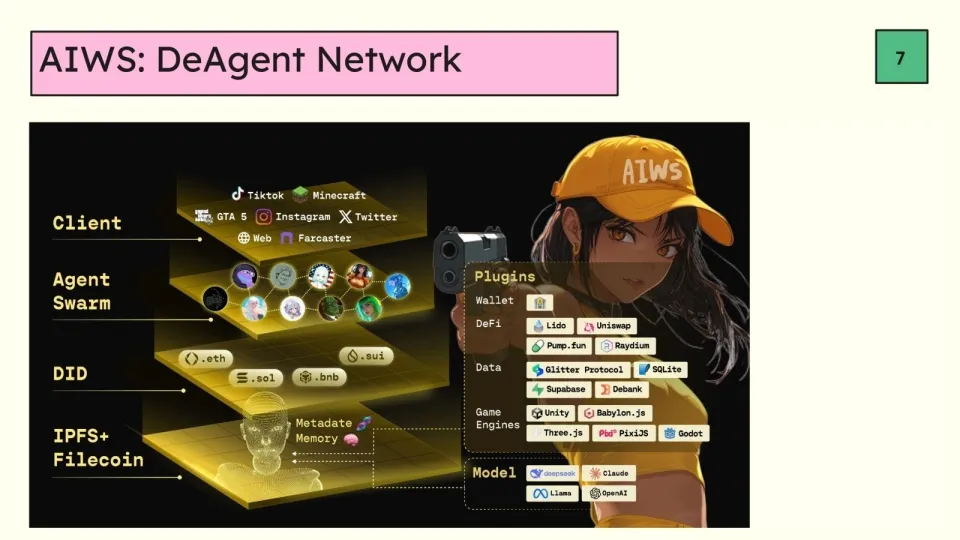
As technology continues to break through, applications deepen, and the era of AI inclusivity approaches, finding a balance between innovation and ethics will become an important issue in future development.
Conclusion
Humanity Enters the "Race" Phase of AI
The breakthrough of DeepSeek has marked an important milestone for humanity, especially for the Chinese in the exploration of AGI. In this context, both encouraging and reflective voices are worth paying attention to; everyone should hope that it can become better and stronger. However, whether its technological route can ultimately withstand the tests of business and market remains to be seen over time.
One point in Wang Feiyue's sharing is particularly noteworthy: AlphaGo, ChatGPT, and DeepSeek are all products of the DeSci model, and we must recognize the role of DeSci, hoping for more "Chinese DeepSeeks" to stand out in the field of artificial intelligence.
Professor Zhu Jiaming mentioned in his sharing that the speed of progress in the era of artificial intelligence surpasses any previous era experienced by humanity. He stated that the AGI era could arrive in as little as two years. While this timeframe may not be precise, the overall trend is indeed so, because once new products or technological routes break the existing balance, it will create pressure on the entire industry, stimulating a collective response from artificial intelligence, which will then lead to a new round of breakthroughs.
Products like DeepSeek are the "external force" that breaks the balance, which is why we see Sam Altman announcing on X that the long-delayed GPT-5 will be made public in a few months.
It is certain that not only OpenAI but also companies like xAI, Meta, and Google will take action.
This technological race concerning the future of humanity has now entered the "race" phase.
免责声明:本文章仅代表作者个人观点,不代表本平台的立场和观点。本文章仅供信息分享,不构成对任何人的任何投资建议。用户与作者之间的任何争议,与本平台无关。如网页中刊载的文章或图片涉及侵权,请提供相关的权利证明和身份证明发送邮件到support@aicoin.com,本平台相关工作人员将会进行核查。




